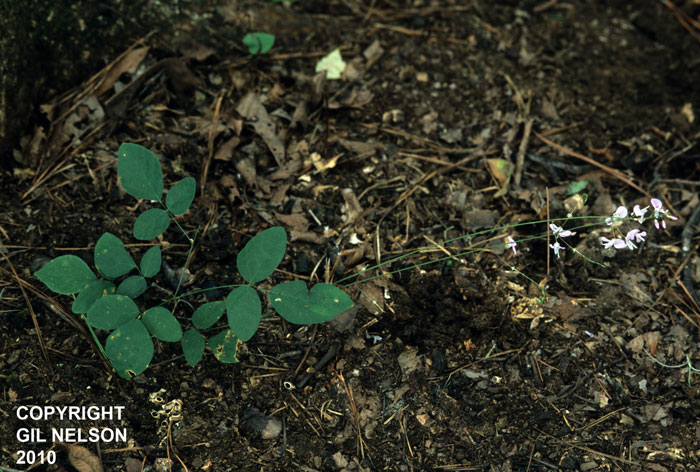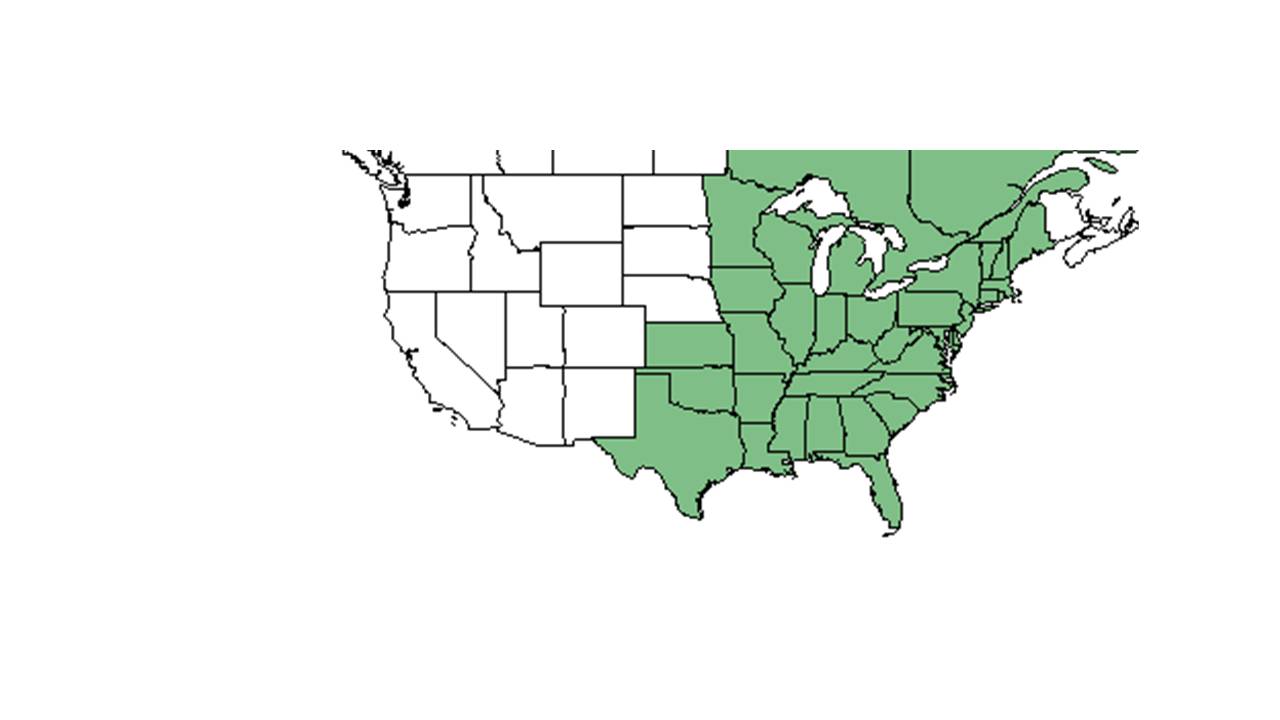Hylodesmum nudiflorum
| Hylodesmum nudiflorum | |
|---|---|

| |
| Photo taken by Gil Nelson | |
| Scientific classification | |
| Kingdom: | Plantae |
| Division: | Magnoliophyta - Flowering plants |
| Class: | Magnoliopsida – Dicotyledons |
| Order: | Fabales |
| Family: | Fabaceae ⁄ Leguminosae |
| Genus: | Hylodesmum |
| Species: | H. nudiflorum |
| Binomial name | |
| Hylodesmum nudiflorum (L.) DC. | |

| |
| Natural range of Hylodesmum nudiflorum from USDA NRCS Plants Database. | |
Common name: Nakedflower ticktrefoil
Contents
Taxonomic notes
Synonyms: Desmodium nudiflorum (Linnaeus) A.P. de Candolle; Meibomia nudiflora (Linnaeus) Kuntze
Description
Distribution
It occurs widely throughout the eastern U.S. and eastern Canada (NRCS Plants Database).
Ecology
The aboveground parts senesce during the autumn and leaves emerge around May. Flowering starts in August, and though each flower is short-lived, flowers can develop sequentially in an inflorescence. It is a nitrogen-fixing legume[1].
Habitat
It can live in a humid climate that experiences extremes in precipitation, wind, and temperature (Chen et al 1997 cited by Concilio et al 2005). It is abundant in cool, temperate, continental climates with acidic, well-drained soils. It occupies areas across light and nutrient gradients, but it occurred most frequently in open and drier areas (Huang and Boerner 2007; Huang et al 2007). It is found in shortleaf pine, hickory, and oak communities (Concilio et al 2005). Herbarium specimens (FSU Herbarium) report its occurrence in mesic woodland, beech-magnolia woods above a permanent streamlet, Apalachicola River bluffs and ravines, pine-oak-hickory woods, pineland near small dry sinks, shortleaf pine-post oak and red oak-mockernut hickory woods, upland hardwood forest in Florida, a wooded bank in North Carolina, rocky ridges above 100 m elevation and dry, novaculate ridges above 340 m elevation in Arkansas, mixed deciduous forest and black oak wood in Michigan, shaley shaded bluffs in Virginia, limestone bluffs in Tennessee, and mesophytic woods in Kentucky. Occurs in frequently burned post-agriculture loblolly and shortleaf pine forest (FSU Herbarium). Light levels are generally shaded (FSU Herbarium). Soil types include dry sandy soil, sandy loam and rich loamy soil (FSU Herbarium).
Associated species include magnolia, beech, pine, oak, hickory, Mitchella repens, mockernut hickory, shortleaf pine, sweet gum, Desmodium orchroleucum, Commelina erecta, Amphicarpaea bracteata, Agrimonia, Matelea, Hexalectris, Toxicodendron, Quercus virginiana, Nyssa sylvatica, loblolly pine, and black oak (FSU Herbarium).
Phenology
Flowers and fruits from June to October (FSU Herbarium).
Seed dispersal
Animals can act as dispersal agents since the fruit coats are covered with abundant, sticky trichomes that attach to their hair (Huang and Boerner 2007). It is generally not affected by dormant season (March-April) low-intensity fires since the heat generated by the fires does not penetrate to where the buds and rootstocks are. Huang and Boerner (2007) found that in their study, that burning alone or with thinning reduces nitrogen and phosphorous concentrations in the soil in the short-term and the long-term (Huang and Boerner 2007). However, burning and thinning increases net photosynthesis rates of D. nudiflorum in the mixed-oak forests of Zaleski State Forest, Ohio. Mean plant biomass was also about two times greater in burned and in burned and thinned plots than in control plots. It is possible that the enhancement of photosynthesis is a result of changes in the forest floor microclimate (e.g., soil temperature, soil moisture, litter depth) (Huang et al 2007). Also, much more nodules were found on D. nudiflorum in the burned and in burned and thinned plots than the control plots, suggesting a potential for greater nitrogen-fixing capability (Huang et al 2007).
Conservation and Management
Cultivation and restoration
Photo Gallery
References and notes
Chen, J., Xu, M., and Brosofske, K.D. 1997. Microclimatic characteristics in the southeastern Missouri Ozarks. In Proceedings of the Missouri Ozark Forest Ecosystem Project Symposium: An Experimental Approach to Landscape Research, St. Louis, Mo., 3–5 June 1997. Edited by B.L. Brookshire and S.R. Shifley. USDA For. Serv. Gen. Tech. Rep. GTR-NC-193. pp. 120–133.
Concilio, A., S. Y. Ma, et al. (2005). "Soil respiration response to prescribed burning and thinning in mixed-conifer and hardwood forests." Canadian Journal of Forest Research 35: 1581-1591.
Florida State University Robert K. Godfrey Herbarium database. URL: http://herbarium.bio.fsu.edu. Last accessed: July 2015. Collectors: Collectors: Loran C. Anderson, Robert K. Godfrey, Gary R. Knight, R. Kral, R. F. Thorne, R. A. Davidson, Gwen Roney, C. Jackson, K. Craddock Burks, A. F. Clewell, Robert Blaisdell, Wilson Baker, Rodie White, Billie Bailey, Marie Victorin, Rolland Germain, Ernest Rouleau, Marcel Raymond, Andre Champagne, Norland C. Henderson, R.E. Torrey, F. Hyland, Edw. Davis, William B. Fox, Delzie Demaree, B. E. Smith, Paul O. Schallert, A. E. Radford, G. W. Parmelee, Paul L. Redfearn, Jr., S.B. Jones, Carleen Jones, Mary E. Wharton, D. R. Windler, S. J. Lombardo, Michael B. Brooks, Randy Warren. States and Counties: Florida: Gadsden, Jackson, Jefferson, Leon, Liberty, Okaloosa, Wakulla. Georgia: Grady, Decatur. Virginia: Alleghany, Montgomery. Massachusetts: Amherst. North Carolina: Swain, Forsyth, Wayne, Jackson. Arkansas: Pulaski, Stone, Garland. South Carolina: Darlington. Michigan: Barry. Ohio: Portage. Mississippi: Smith, Webster. Missouri: McDonald, Barry. Tennessee: Lewis. Illinios: Lawrence. Kentucky: Clark. Alabama: Cherokee, Choctaw. Maryland: Baltimore. Other Countries: Canada. Compiled by Tall Timbers Research Station and Land Conservancy.
Huang, J. J. and R. E. J. Boerner (2007). "Effects of fire alone or combined with thinning on tissue nutrient concentrations and nutrient resorption in Desmodium nudiflorum." Oecologia 153: 233-243.
Huang, J. J., R. E. J. Boerner, et al. (2007). "Ecophysiological responses of two herbaceous species to prescribed burning, alone or in combination with overstory thinning." American Journal of Botany 94: 755-763.
NRCS Plants Database http://plants.usda.gov/java/
- ↑ Huang, J. J. and R. E. J. Boerner (2007). "Effects of fire alone or combined with thinning on tissue nutrient concentrations and nutrient resorption in Desmodium nudiflorum." Oecologia 153: 233-243.